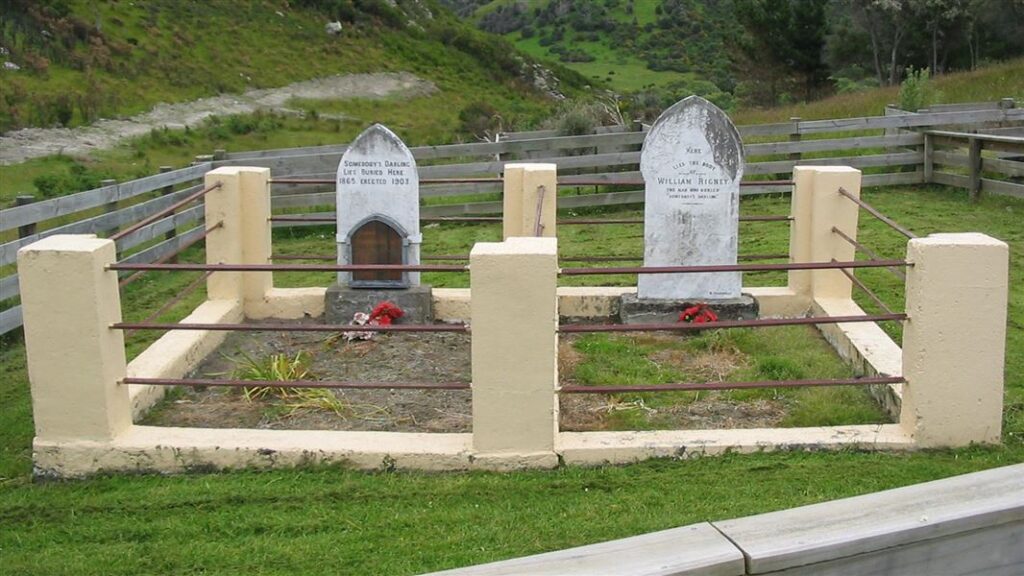Near the Clutha Gold Cycle Trail in Central Otago, a gold settlement called Rigney once supported 200 miners and storekeepers while they worked a field at Horseshoe Bend on the Clutha River between 1863 and 1865. On a barren hill near where Rigney once stood, the most emotive pair of graves in New Zealand tell a story of kindness and loss. Romanticized myth and legend surround the two forlorn headstones known as the ‘Lonely Graves’.

THE STORY AS HANDED DOWN THROUGH HISTORY
‘In February 1865, the body of a young man was discovered on the banks of the Clutha River. A shivering wet dog sat guard over the body when it was discovered by miner William Rigney. The smooth hands and fine features of the young man suggested he was not a miner. William thought he looked aristocratic and considered the possibility he was a young lord. He became obsessed with the mysterious body which was never identified and took it upon himself to arrange a burial in a suitable grave which he had arranged on a hillside nearby.’
The above story appeared in the local newspaper, Tuapeka Times in January 1901. William Rigney, by then an elderly man, read it and contacted the paper to put the story straight. He said he had neither discovered or buried the body. An inquest held on 22nd February 1865 concluded the supposed young nobleman was in fact the body of Charles Alms, a young butcher from the Nevis Valley who had drowned further up the river in Clyde while crossing cattle over the river in January 1865.
ATTENDING THE GRAVE
William Rigney felt pity for the unidentified body and did in fact, erect a wooden fence around the grave. At the head of the burial plot he placed a length of pine planking and wrote the words “Somebody’s Darling Lies Buried Here”. Because of these words, a charming legend was born. In 1903, with the help of public subscription, a marble headstone was purchased and placed behind the original pine plank. For 48 years, William kept a lifelong interest in the grave and before he died in 1912, he requested that he be buried beside ‘somebody’s darling’ so he would at least have company in death. He felt he too would soon be forgotten and didn’t want to be buried in a lonely grave.
Two marble headstones now stand side by side in the isolated Central Otago location. On the second one, although incorrect, the words “Here lies the body of William Rigney, the man who buried “Somebody’s Darling” have been etched into the marble. The legend of the ‘Lonely Graves’ is now part of the rich history of the Otago goldrush era and has become an increasingly popular site to visit. It is one of many tragic, yet rather romantic human stories that are associated with Otago’s early history.
Footnote: In 2000 the headboard with “Somebody’s Darling Lies Buried Here” went missing. A wide search of the area produced nothing. It eventually turned up outside a police station in Wellington. One of the detectives was fascinated by the headboard and the words on it and undertook an investigation. This resulted in the eventual return of the historic relic which is now secured by bolts to the marble headstone over the appropriate grave.
Ceidrik Heward
Ceidrik Heward is an Amazon TOP SELLING AUTHOR and has lived and worked in 7 countries working as a TV cameraman, director and film tutor. For the past 17 years he has focused on writing and has been published in magazines and newspapers in Europe, USA, Asia and the Middle East.
His interests include photography, psychology and metaphysics. He loves to read and always has at least 3 books on the go. He has written 22 manuals/books and has just completed his 4th short novel. Ceidrik believes sharing information and stories is the best way to stimulate the imagination and enrich our lives.




















 Visit Today : 282
Visit Today : 282 Total Visit : 1133459
Total Visit : 1133459
Nice one Ceidrik, although in my memory the graves are not on a hill, only a little bit of a rise beside the river.
Thanks for the comment Ray. I followed the research on the location as I have not seen them in real life. I guess a ‘rise’ was interpreted as a ‘hill’ in the published data on the site. I try and get the facts in my blogs right. I am careful with my research and often facts are contradicted which makes things difficult.